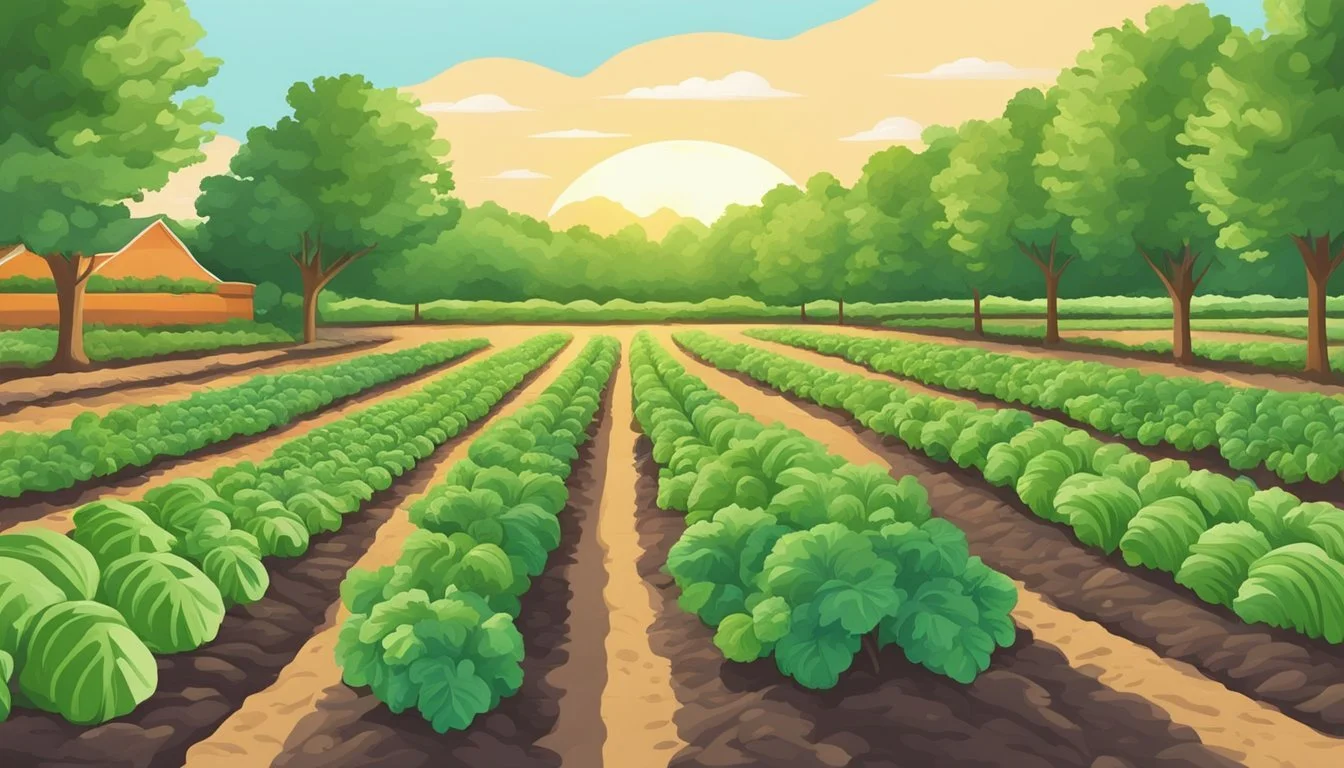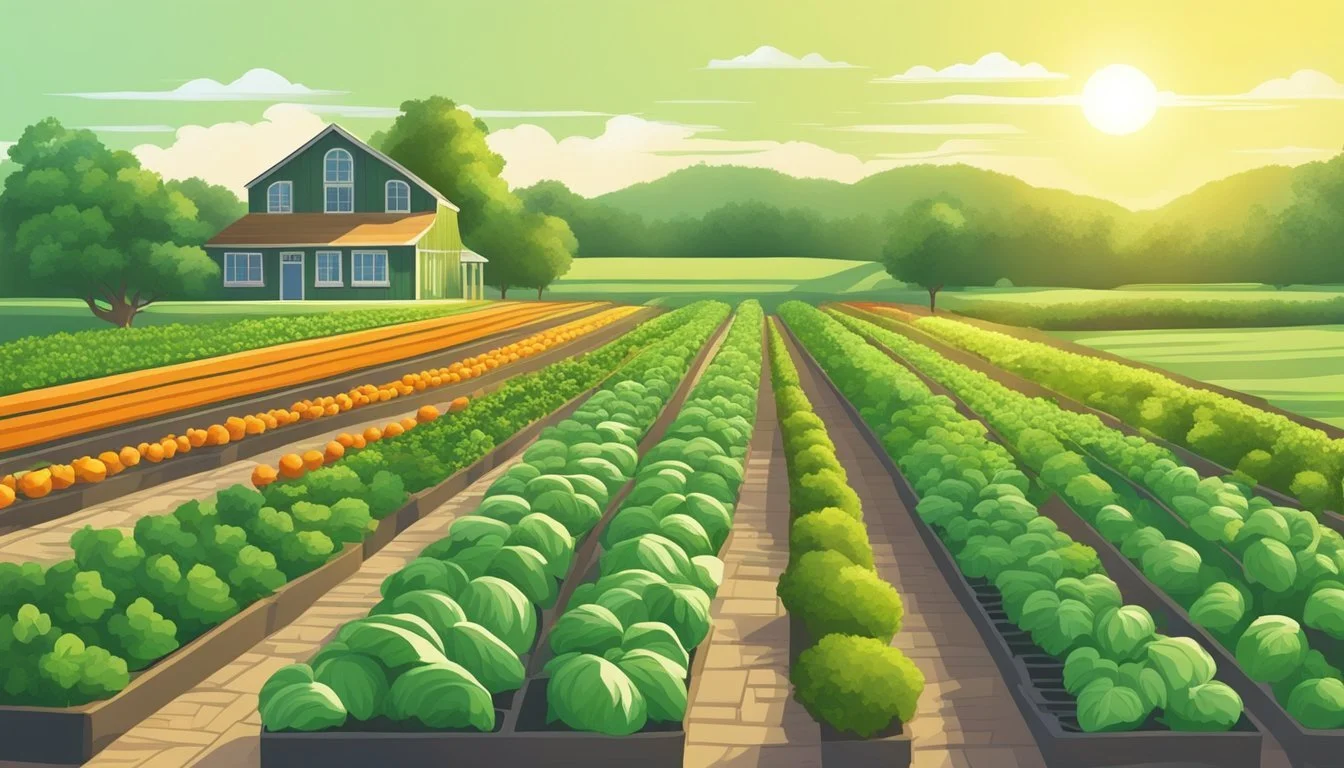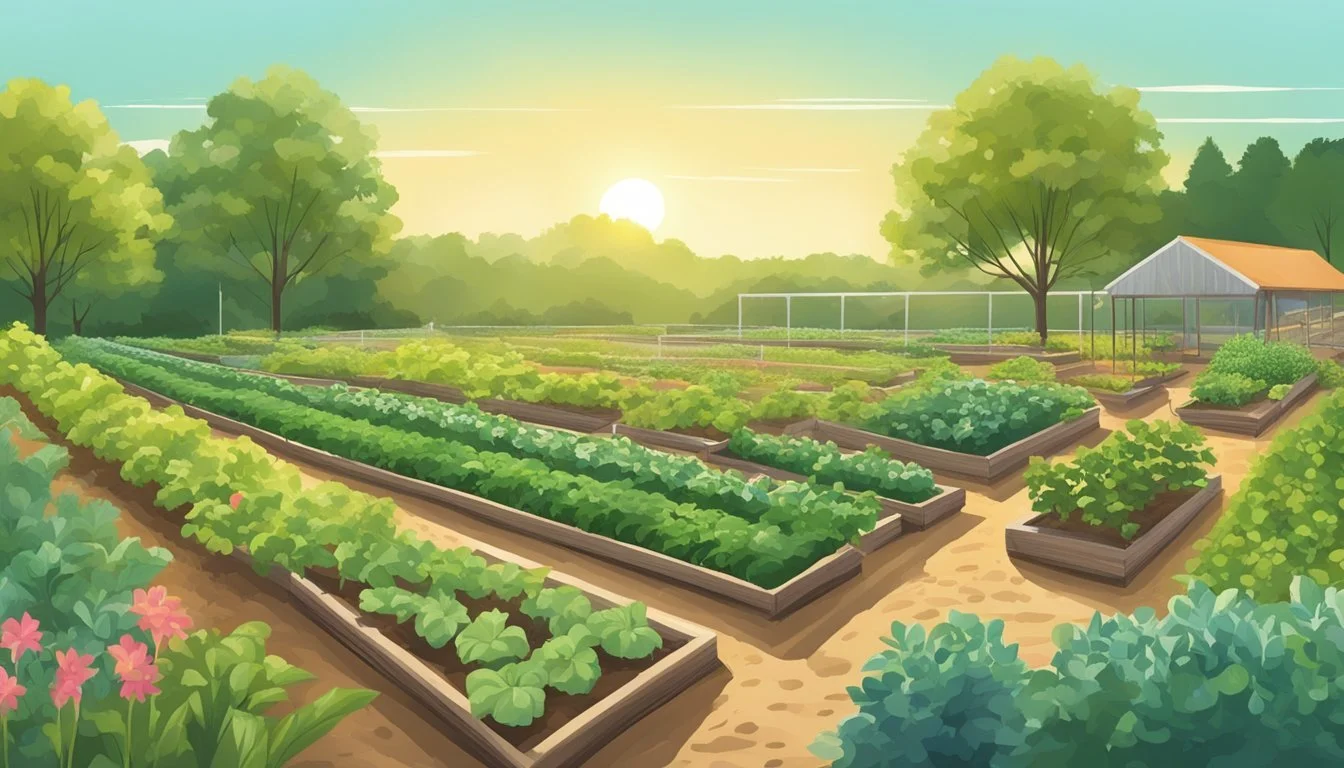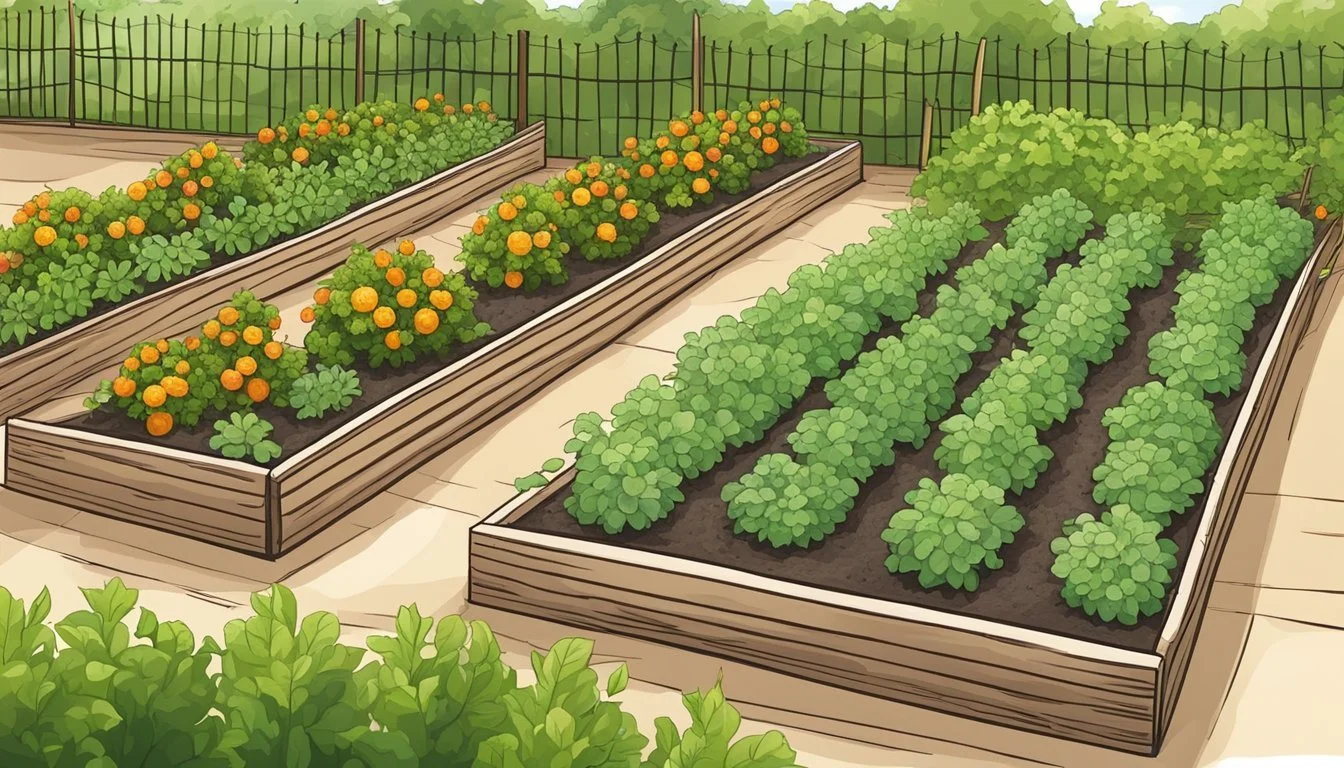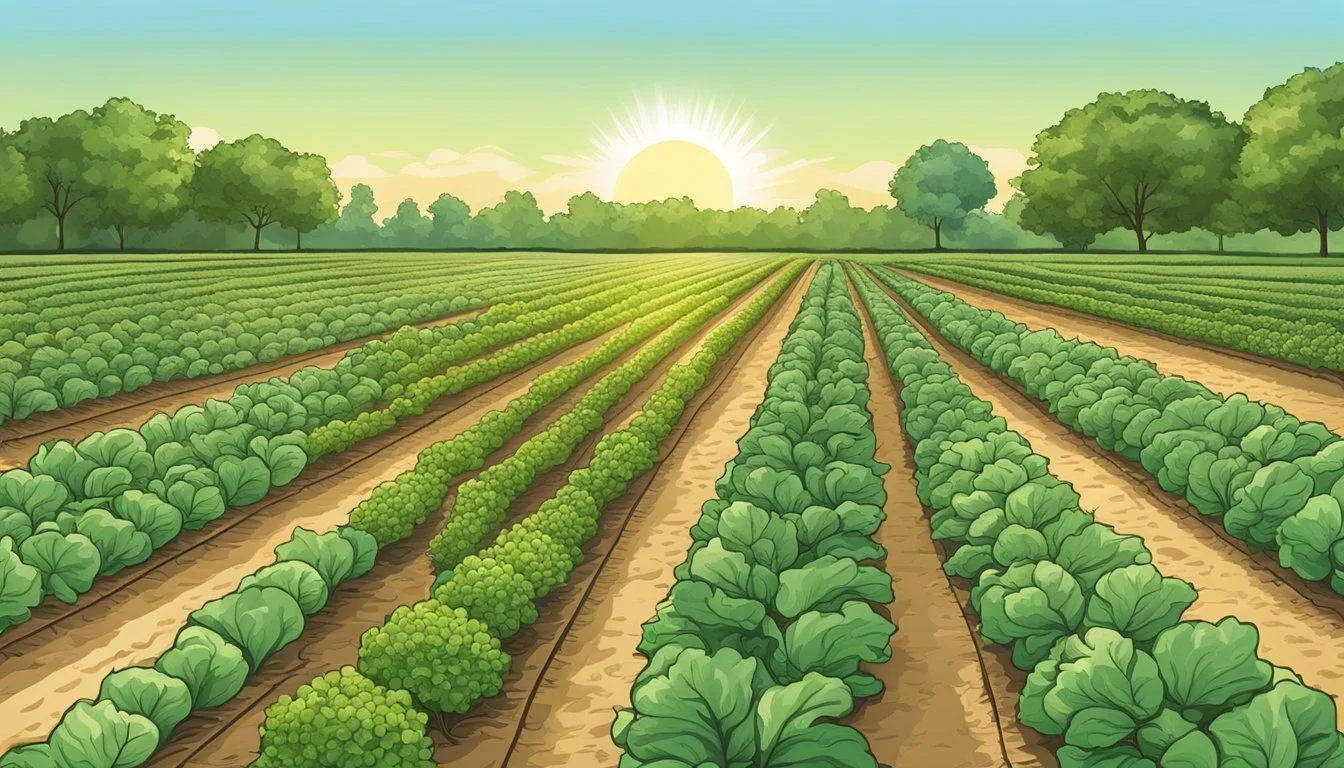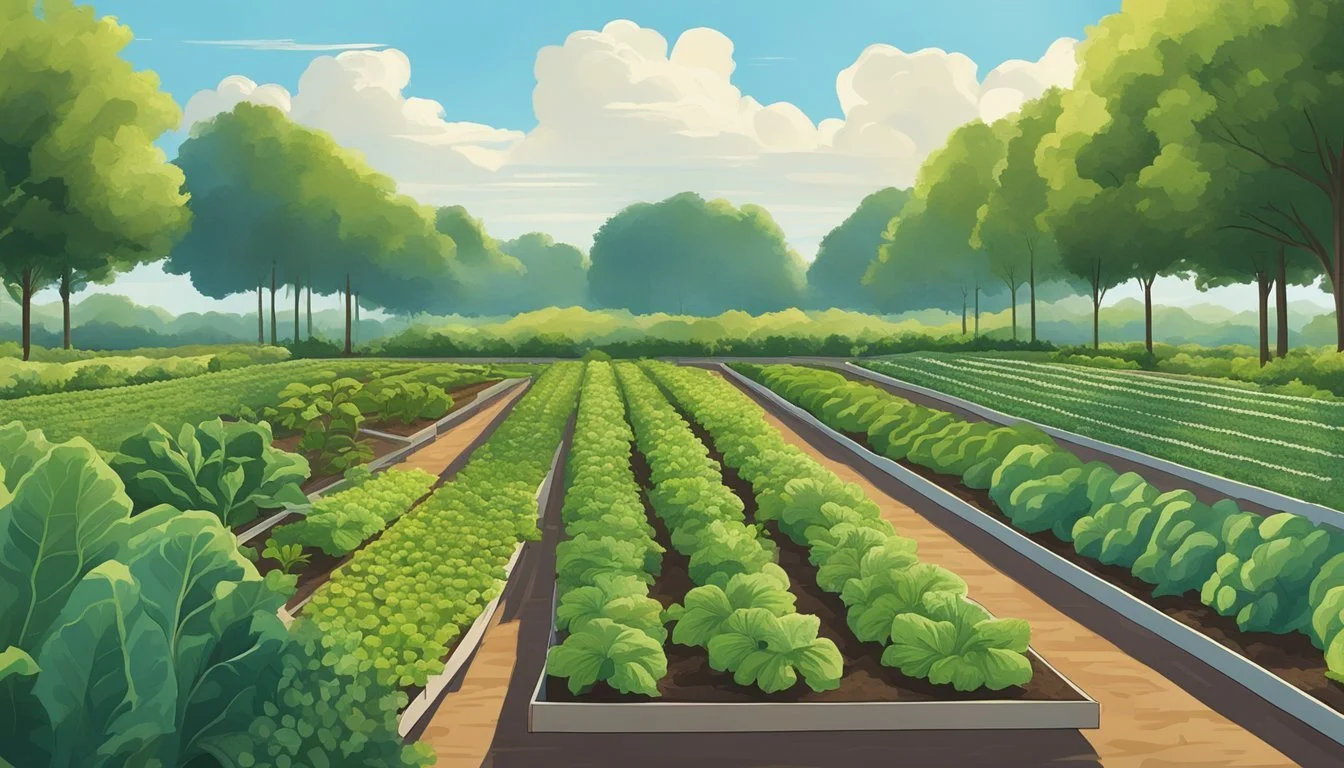Vegetable Gardening in Alabama
A Guide to Year-Round Harvests
This Article is Part of Our Guide on Vegetable Gardening by State
Vegetable gardening in Alabama offers a rewarding opportunity for residents to cultivate a variety of plants in the region's conducive climate. Alabama's weather, characterized by hot summers and mild winters, supports the growth of a wide range of vegetables. Gardeners in this state can enjoy the satisfaction of planting and harvesting their own food, which can lead to healthier eating habits and a deeper connection to the environment. The state’s ample sunlight, adequate rainfall, and extended growing season make it an ideal location for both novice and experienced gardeners to develop a thriving vegetable garden.
To maximize success, understanding the local conditions is crucial. Alabama's soil typically requires a pH level between 6.0 and 6.5, and amendments like lime might need to be mixed into the soil prior to planting to achieve these conditions. Long-season crops such as tomatoes, cabbage, peppers, okra, and potatoes benefit from the state's long growing periods and may require more fertilizer than short-season crops.
Strategic planting is key in Alabama's vegetable gardening. For example, lettuce is particularly suited to the colder months, thriving in Alabama's cool springs and falls, making it an excellent choice for gardeners looking to extend their growing season. Meanwhile, warmth-loving vegetables like tomatoes and peppers excel in the state's hot summers. This adaptability in crop selection allows Alabama gardeners to produce a continuous yield of fresh vegetables throughout the year.
Understanding Alabama's Climate
In the context of vegetable gardening, Alabama's diverse climate stands out with its humid subtropical conditions, which are characterized by typically hot summers and mild winters. This climate significantly influences the growing seasons and the types of vegetables that can thrive across the state.
USDA Hardiness Zones
Alabama encompasses a range of USDA Hardiness Zones, primarily falling into Zone 8. This categorization assists gardeners in understanding the most suitable plants for their locale and the optimal timing for planting and harvesting.
Zone 7a: Found in the northern highlands, articulating a shorter growing season with cooler temperatures.
Zone 8a to 8b: Covering a large central area, offering a balance between warm and cool, favoring a longer growing season.
Zone 9a: Located in the southernmost parts, providing the longest growing season due to warmer overall temperatures year-round.
Gardeners can strategically utilize these zones to maximize their vegetable yields by aligning planting schedules with the corresponding climate conditions of their specific region within Alabama.
Soil Preparation and Management
Proper soil preparation is critical for a successful vegetable garden in Alabama. Understanding the regional soil types, how to fertilize effectively, and the keys to adequate drainage and watering practices will lead to rich, productive gardens.
Soil Types
In Alabama, gardeners typically encounter a range of soil types from sandy loam to heavy clay. Each type presents its own set of advantages and challenges. It's crucial for them to test the soil for nutrient content and pH level; ideal pH levels for most vegetables lie between 6.0 and 6.8. Amending soil with organic matter annually can improve soil structure, foster beneficial microbial activity, and enhance the garden's overall fertility.
Fertilizing
To fertilize correctly, they first need to understand the specific needs of their plants and the existing nutrient levels in their soil. A balanced approach often entails a mix of N-P-K (nitrogen, phosphorus, and potassium), with attention to correcting any micronutrient deficiencies indicated by soil tests. Gardeners should apply fertilizers at the right times in the growing season to support plant growth without promoting excessive foliage at the expense of fruit production.
Nitrogen: Essential for leaf growth
Phosphorus: Required for root development
Potassium: Keeps overall functions of the plant in balance
Drainage and Watering
Effective water management hinges on well-designed drainage. Over-watering can lead to root diseases, while under-watering stresses plants and diminishes yields. Alabama gardeners must ensure their soil can retain moisture but also allow excess water to drain away. Using techniques such as drip irrigation can provide consistent moisture, conserve water, and reduce the likelihood of leaf diseases. Soil that consistently retains water may need organic amendment to improve its structure and drainage capacity.
Selecting the Right Vegetables
In Alabama, successful vegetable gardening depends on planting the appropriate vegetables during the optimal seasons. They must understand which vegetables thrive in the cool season and which prefer Alabama’s warm season to ensure a bountiful harvest.
Cool-Season Vegetables
Cool-season vegetables are well-suited to the milder temperatures in early spring and late fall in Alabama. They often have a good tolerance for light frost and can sometimes be cultivated throughout the winter months. Gardeners should focus on:
Lettuce: Plant early as it thrives in cooler weather.
Spinach: Prefers the cool dampness of Alabama's spring and fall.
Cabbage: Can be harvested into the winter if planted at the right time.
Broccoli and Cauliflower: Perform best when they can mature in cooler air.
Carrots and Radishes: Root vegetables that are ideal for a fall harvest.
Peas: Should be planted as soon as the soil is workable in early spring.
Kale and Collards: Leafy greens that are more flavorful after a frost.
Cool-Season Vegetable Planting Time Notes Lettuce Early spring, late fall Prefers cool, not cold weather Spinach Early spring, fall Durable in damp coolness Carrots Early spring, fall Sweetens with cool temperatures Peas Early spring Plant when soil is workable
Warm-Season Vegetables
Warm-season vegetables should be planted after the last frost has passed, typically in late spring, as they rely on warm soil and higher temperatures for proper growth. These include:
Tomatoes: Require substantial sunlight and warmth.
Peppers: Need long, sunny days to develop flavor and heat.
Cucumbers: Prefer heat and often require consistent watering.
Squash: Thrives in the heat and can be very productive.
Okra: Loves the heat and grows well in Alabama summers.
Green Beans: Need warm soils; suitable for late spring planting.
Sweet Potatoes: Have a long growing season; plant once warm.
Eggplant: Requires a long, warm growing season.
Warm-Season Vegetable Planting Time Notes Tomatoes Late spring Full sun, warm soil Peppers After last frost Sunny days for best flavor Cucumbers Late spring Warmth, consistent watering Okra Late spring Heat-loving, suited for Alabama
By considering the seasonal preferences of these vegetables, Alabama gardeners can plan for a continuous harvest throughout the gardening season.
Planting Your Vegetables
When embarking on vegetable gardening in Alabama, gardeners should consider the seasonal timing and the specific requirements for starting from seeds (how long do seeds last?) or transplanting seedlings. It is crucial to adhere to planting schedules and understand the needs of each vegetable type to ensure a thriving garden.
Starting from Seeds
Seed Selection: Gardeners should select seeds suited to Alabama's climate; tomatoes, peppers, squash, okra, cucumbers, green beans, and sweet potatoes fare well. It's best to plant seeds at the optimal time, considering Alabama's mild winters and hot, humid summers.
Planting Schedules: Seeds for long-season crops should typically be sown in early spring to ensure they are established before the heat intensifies. Lettuce and other cold-hardy vegetables can be sown in both the cool springs and the fall. A fall vegetable garden is ideal for these crops, as they can tolerate light frosts.
Spring Planting:
Tomatoes, peppers: start indoors 6-8 weeks before last frost date
Squash, cucumbers, beans: sow directly after the chance of frost has passed
Fall Planting:
Lettuce, greens: sow in late summer for autumn harvest
Transplanting Seedlings
Soil Preparation: Prior to transplanting, ensure the soil pH is around 6.0 to 6.5 by mixing lime into the soil if necessary.
Fertilizing: Transplants such as tomatoes and peppers may require more fertilizer than short-season crops. Side-dressing with fertilizer should be guided by the plant's growth and appearance.
Crop Rotation: To minimize disease and maximize soil nutrients, implement crop rotation, planting different vegetables in a location each season.
Transplanting Steps:
Harden off seedlings to adjust them to outdoor conditions.
Plant after the last frost date for spring or early summer for fall crops.
Space according to the specific needs of each vegetable.
Water thoroughly after planting.
By respecting Alabama's gardening calendar and providing appropriate care to seeds and seedlings, gardeners can establish a robust and productive vegetable garden.
Vegetable Garden Maintenance
Maintaining a vegetable garden in Alabama requires diligent care to ensure the health and productivity of the plants. Gardeners must effectively manage pests and diseases, regulate weeds through mulching, and meet the watering and nutrient needs of their crops.
Pest and Disease Management
Regular monitoring of the garden is essential for early detection and control of pests and diseases. Gardeners should look for signs of infestation or illness, such as discolored leaves or damaged produce. Alabama gardens often face threats from pests like aphids, hornworms, and stink bugs, as well as diseases such as blight and mildew.
Common pests:
Aphids
Hornworms
Stink bugs
Prevalent diseases:
Blight
Powdery mildew
For nematode management, methods like crop rotation and organic insecticides can be effective. Organic measures not only control pest populations but also help to minimize the impact on beneficial insects within the garden ecosystem.
Weeding and Mulching
Weed control is critical for preventing competition for resources. Weeds can be managed through regular hand-pulling and the use of mulches.
Benefits of mulching:
Conserves soil moisture
Reduces weed growth
Provides a barrier against soil-borne diseases
Gardeners should apply natural mulch materials such as straw or wood chips to the base of their plants. This layer not only suppresses weeds but also contributes to maintaining consistent soil temperatures and moisture levels.
Watering and Nutrient Requirements
Watering needs vary depending on the type of vegetable and the stage of growth. Vegetables with large leaves or fruit, like tomatoes and squash, may require more frequent watering compared to root crops. Consistent moisture at the soil level is key to avoiding stress on the plants.
Watering guidelines:
Water early in the day to reduce evaporation
Utilize drip irrigation to target the root zone and conserve water
Fertilizer application should be done according to the nutrient demands of each vegetable. Long-season crops such as tomatoes and potatoes typically need more fertilizer compared to shorter-season crops. Gardeners can apply a balanced, slow-release fertilizer at planting and side-dress with additional nutrients as needed during the growing season.
Harvesting and Enjoying Your Vegetables
Harvesting your vegetables at the right time ensures optimal flavor and nutritional value, while correct techniques can help preserve the integrity of the vegetables and the health of the plants.
Harvesting Techniques
Approaching the harvest with the right technique is crucial for the gardener's success. They should use:
Scissors or Pruning Shears: For cutting stems cleanly without damaging the plant.
Gloves: To protect their hands from cuts and irritation, especially when harvesting vegetables like squash and cucumbers.
Baskets or Containers: To hold the vegetables without bruising or squashing them.
When harvesting leafy greens, one should pick the outer leaves first to allow the plant to continue growing. Root vegetables require gentle loosening of the soil around them before pulling to prevent breakage.
Optimal Harvest Timing
The timeframe for harvesting vegetables can vary greatly and is often indicated by the "days to harvest" listed on seed packets. In Alabama, a gardener should consider:
Tomatoes: They are typically ready for harvest when they are firm and fully colored.
Cucumbers: Best picked when they are medium-sized and still firm.
Green Beans: They are prime when they are firm and have a snap to them but before the seeds inside begin to bulge.
Vegetables like squash and okra should be harvested when they are immature for the best taste and texture. Most importantly, morning harvests are often best, as this is when vegetables are most hydrated and crisp.
Gardening Diversity and Techniques
Alabama's climate creates an opportunity for a variety of gardening techniques that optimize space and cater to a diversity of plants. Gardeners can leverage methods like raised beds and containers for controlled soil conditions, or vertical gardening to maximize small spaces.
Raised Beds and Containers
Raised beds provide an excellent option for gardeners seeking to improve soil conditions and drainage. Containers, on the other hand, are ideal for the mobility they offer and are suitable for spaces such as patios and balconies. Both options allow for:
Customizable soil mix: Amend soil specifically suited to your plants' needs.
Better control of moisture: Raised beds and containers facilitate good drainage, reducing the risk of root rot.
Extended growing season: The soil in raised beds and containers warms up faster, which can lengthen the growing season.
Gardeners in Alabama should consider the following for raised beds and containers:
Size: Containers should be large enough to accommodate the root growth of the chosen plants.
Material: Cedar and redwood are durable choices for raised beds, while containers can be clay, plastic, or metal.
Vertical Gardening
Vertical gardening is a technique that allows the gardener to grow plants upwards, which is particularly beneficial when horizontal space is limited. This method make use of vertical space on walls, trellises, or stacks. It's especially useful for:
Small garden areas: Apartment balconies and small backyards can become lush with vegetation.
Climbing plants: Plants such as tomatoes, cucumbers, and pole beans that naturally grow vertically.
Gardeners in Alabama can employ vertical gardening by using:
Trellises and supports: Structures that provide support for climbing and vining plants.
Hanging containers: An option for plants that thrive in both direct sunlight and shaded environments.
By implementing raised beds, containers, and vertical gardening techniques, even those with limited space can enjoy the full spectrum of homegrown vegetables in Alabama's climate.
Planning for Success
Effective planning is the cornerstone of a successful vegetable garden in Alabama. A gardener must understand local frost dates and have the right tools and resources at their disposal.
Understanding Frost Dates
Frost dates in Alabama vary significantly across different regions. Gardeners must prepare for the first and last frost by consulting local frost date calendars to ensure optimal planting times. For example:
Spring Frost Dates: Planting should occur after the last expected spring frost to prevent damage to seedlings.
Fall Frost Dates: Harvest should be completed or protection should be provided before the first expected fall frost.
Typical Frost Dates for Alabama:
Region Last Frost (Spring) First Frost (Fall) North Alabama Mid-April Early November Central Alabama Early April Mid-November South Alabama Late March No typical frost
Garden Tools and Resources
To maintain a thriving vegetable garden, a gardener must possess both basic and specialized garden tools. Essential tools include:
Shovels for preparing the soil
Rakes for leveling and cleaning debris
Hoes for weed control
Watering cans or systems to ensure plants receive adequate water
Sun and weather monitoring tools to track and respond to environmental conditions.
In addition to garden tools, gardeners should utilize the wealth of publications by local gardening experts and the Alabama Cooperative Extension System for regional-specific advice.
Engaging with Local Resources
In Alabama, vegetable gardeners can significantly benefit from leveraging dedicated local resources. Two of the most valuable are the Alabama Cooperative Extension System and local gardening communities, which provide comprehensive guides, expert advice, and a platform for peer support.
Alabama Cooperative Extension System
The Alabama Cooperative Extension System (ACES) offers an array of resources tailored to assist Alabama gardeners. They produce detailed publications and guides, covering topics from vegetable selection to pest management. ACES resources are vital for any gardener, from novices to experienced green thumbs, looking to grow vegetables or ornamentals, and even for bird enthusiasts aiming to create bird-friendly gardens. Gardeners in Birmingham or other Alabama cities can access these publications to bolster their knowledge and achieve a successful gardening experience.
Publications: Includes a variety of books and online materials.
Expertise: Focus on local plant varieties, pests, and climate considerations.
Contact Information: Gardeners with immediate questions can use the Alabama Master Gardener Helpline at 1-877-252-4769.
Local Gardening Communities
Local gardening communities across Alabama serve as excellent platforms for gardeners to exchange insights and seek advice. These communities, often organized through garden centers or independent nurseries, can offer hands-on experience and advice specific to neighborhoods and local climates. They also host seminars and workshops, providing opportunities for gardeners to connect and learn from one another.
Local Nurseries: Source of quality plants and personalized advice.
Community Events: Seminars and workshops for knowledge sharing.
Networking: Connections with fellow gardening enthusiasts.
Expanding Your Gardening Knowledge
When embarking on vegetable gardening in Alabama, education is crucial. New gardeners should understand the regional climate and soil specifics to foster a thriving garden. Resources like the Alabama Cooperative Extension System’s publications provide a fertile ground for learning. Gardeners can gain insights from proven techniques tailored for Alabama's distinct seasons.
For beginner gardeners, starting with root vegetables can be rewarding due to their hardiness and lower maintenance. The soil in Alabama is often suitable for these types of vegetables, but one should always test the soil before planting. Key focus areas include:
Soil Preparation: Learn about soil amendments and nutrient management for optimal root vegetable growth.
Pest Control: Identify common pests and diseases in Alabama and best practices for organic control.
Seasonal Planting Charts are essential for timing. Alabama's extended growing season allows for multiple cycles of planting and harvesting. The Alabama Cooperative Extension System offers detailed planting guides.
Practical Tips:
Ensure at least six hours of sunlight daily for most vegetables.
Practice crop rotation to prevent disease and maintain soil health.
Workshops and Gardening Clubs:
Attending local workshops.
Joining gardening groups for shared knowledge.
Tools for Success:
Item Use Garden Planner For crop scheduling. Soil Test Kit To assess soil needs.
By leaning into these educational tools and practices, gardeners can confidently cultivate prolific vegetable gardens in Alabama.
Creating an Organic Vegetable Garden
An organic vegetable garden offers Alabama residents a way to indulge in fresh produce that's free from synthetic chemicals and pesticides. A gardener must begin by choosing a site with plentiful sunshine, as most vegetables require at least six hours of direct sunlight per day.
Site Preparation
Soil Testing: Testing the soil helps to determine pH levels and soil type, allowing for appropriate amending.
Organic Matter: Incorporate compost or aged manure to improve soil fertility and structure.
Mulching: Apply organic mulch to conserve moisture and suppress weeds.
Seed Selection and Planting
Choose seeds approved for organic use, ensuring they come from plants grown without prohibited substances.
Sow seeds in flats or large containers rather than cell packs, reducing waste if germination is uneven.
Caring for Your Garden
Watering: Provide regular watering, especially during dry spells, to maintain steady growth.
Weed Control: Hand-pulling weeds or using organic mulches helps manage unwanted plants without chemicals.
Pest Management: Use natural predators, barriers, or organic pesticides as necessary, always adhering to organic standards.
Plant Choices
Select vegetables that thrive in Alabama's climate, like tomatoes, squash, and sweet potatoes.
Introduce a variety like lettuce, which is cold-hardy and low-maintenance, suitable for cooler seasons.
When establishing an organic garden, careful planning and knowledge of Alabama's climate contribute significantly to its success. Adhering to organic practices from seed start to harvest ensures a bountiful and healthy crop for the table.
Special Considerations for Alabama Gardeners
Alabama gardeners face unique challenges and opportunities due to the state's diverse climate and soil compositions. It's crucial for gardeners to be well-informed by referring to credible publications and journals to ensure a bountiful harvest.
Soil Acidity: For vegetables like onions, jalapenos, and cucumbers to thrive, soil pH levels should range between 6.0 and 6.8. Gardeners should regularly test their soil and adjust it with lime or sulfur to maintain slight acidity.
Climate Zones: The climate varies significantly from the northern highlands to the coastal areas. Gardeners in the Birmingham area typically find themselves in USDA Zone 7a, which affects planting schedules and crop selection.
Pest Management: Bugs can pose a significant threat to vegetable gardens. Effective pest control strategies are key, and gardeners should stay updated on local extension service recommendations.
Gardeners must stay current with the latest advice available in reliable gardening manuals specific to Alabama. These resources provide month-to-month guidance on planting, maintaining, and monitoring gardens for optimum results.
Season Vegetable Planting Consideration Winter Cabbage Can be harvested throughout the season. Summer Tomatoes Benefit from the long, warm growing period.
Alabama's mild climate affords gardening nearly year-round, but keen attention to these special considerations is essential for a successful vegetable garden.
Conclusion
Gardening in Alabama can be a rewarding endeavor due to the state's mild climate and long growing season. Key considerations such as soil preparation, plant selection, and maintenance practices are crucial for a bountiful harvest.
Soil Preparation: Before planting, ensure that the soil is fertile and well-drained. Incorporating organic matter can improve soil structure and fertility. A soil test can guide the amendment process for optimal plant growth.
Plant Selection: Certain vegetables thrive in Alabama's climate. These include:
Tomatoes
Peppers
Bright and hearty squash
Diverse cucumbers
Richly-flavored sweet potatoes
Green beans for fresh or preserved consumption
Okra, a Southern favorite
Planting Times: Timely planting is essential. Vegetables like cabbage and kale may be harvested through winter, while heat-loving varieties like tomatoes prosper during the summer months. Abiding by a planting calendar can lead to better yields.
Maintenance: Regular watering, pest management, and monitoring for diseases help maintain a healthy garden. Strategies like mulching can conserve moisture and control weeds.
Tips for Success:
Give plants enough space to avoid overcrowding.
Understand each vegetable's specific needs.
Protect plants from extreme temperatures.
By following these guidelines, Alabama gardeners can expect to enjoy plentiful and flavorful vegetables throughout the year.

